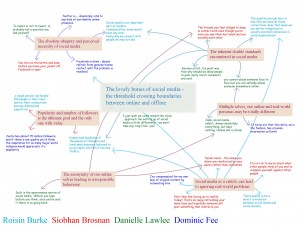This is my contribution to a collaborative writing project, which had a loose theme of “The Highs and Lows of Social Media”….
“Twitter is hard, and scary, and hard, but people keep saying it’s currently the most important social networking tool, and absolutely vital to any kind of worthwhile online presence. So no pressure then. But as a newbie, where are you supposed to start? Well, with an example of a really good tweet I suppose. Let’s see…
‘Facebook is down. Please refrain from genuine human contact until the problem is resolved.’
Now that’s good! It’s satire, because it implies that people who use social networking sites have no actual interpersonal skills, but it also, you know, is a piece of social networking itself. So it’s a kind of double strength satire. It turns out this tweet was written by no less a person, I mean Person, than God. Despite shouldering the responsibility of creating and overseeing the universe, apparently He can still find time to tweet on topics as diverse as Wimbledon, Donald Trump’s presidential aspirations and gun ownership. It turns out that this deity, as is the fashion, has a human incarnation on Earth. David Javerbaum is an Emmy award-winning American comedy writer whose writing credits include The Daily Show with Jon Stewart and The Late Show with David Letterman. He has been running @TheTweetOfGod since October 2010, and has to date gathered an impressive flock of over 2.15 million followers.
Jauverbaum’s background as a professional writer shines through on his Twitter feed. Frequently hilarious, often topical and regularly poignant, his tweets are the best lesson I’ve seen in constructing messages of 140 characters or less. Assuming the identity of one of history’s most feared / worshipped creators gives him a unique perspective from which to comment on humanity’s peculiarities. You might assume that being omnipotent and omniscient would leave God with nobody to look up to. He does however, follow just one person on Twitter – Justin Bieber. Justin has almost 70 million followers, and if there’s one quality you’d think the inspiration for so many major world religions would appreciate it’s popularity. Except now Katy Perry has even more followers. Sort it out God.
Hardly the most avid of social networkers myself, I have only recently set up a Twitter account. I’ve barely used it yet, and with an almost saintly restraint have resisted the urge to indulge in that most basic of human instincts and tweet endlessly about cats and how cute they are. Just as many people of a religious persuasion turn to their God(s) in times of need for solace and guidance, I turn to mine in the hope that some of His literary technique, satirical turn of phrase and 2.15 million followers might come my way. I’ve compensated for my own lack of original content by retweeting Him (I may not know much about microblogging, but I know what I like.) Though my start on Twitter has been a little shaky, I know I can do better. With God’s help.”


